Steemit Crypto Academy | Season 2: Blockchain and Platforms by @alphafx
Blockchain Platforms
Hello, welcome to my first lecture on season 2 of the SteemitCryptoAcademy. I am honoured to be here amongst you, sharing the little I know, and learning too. Today we will start from the unit of life of this Decentralised Universe, Blocks and blockchain. I hope you enjoy the lesson, questions will be appreciated and answered as promptly as possible.
What exactly is Blockchain?
The first word I heard while looking into the crypto verse was BLOCKCHAIN. I’m sure you have come across it numerous times too. But what really is blockchain? If you did a little bit of elementary economics, you will know about ledgers, balance sheet, spreadsheet and all other types of manual records. These record are stored on servers with certain capacities. Although sometimes are accessible to the public, they are usually controlled by one central organisation. In contrast yet similarity, blockchain is an electronic database of transactions verified by multiple computers linked in a peer-to-peer system. Transaction here are recorded in “blocks”. When these blocks are filled to capacity, they are chained to the previously filled block, hence the name “BLOCKCHAIN”.
This should not limit your view of the blockchain, because in as much as here, we focus on the transactional aspect of the blockchain technology. This tech basically keeps records decentralized and I want you to let your imagination run wild on a global level, how revolutionary this could be. Governments could use it for more transparent elections, companies could use it for a more accurate and manipulation proof system of record keeping, it is limitless!
Why is blockchain revolutionary?
DECENTRALIZATION
Owing to the fact that the blockchain technology requires storage of its data on different computers, these computers are located far apart geographically and called nodes, they store every transaction ever made on the blockchain, leaving no node as central power, unlike when a company owns a database and keeps the computers it’s stored on in a central secured location. If there is an alteration on one of the nodes by the user, all the other nodes cross reference each other, to scan and identify and correct the tampered node. This ensures that the database is decentralized and maintains transparency.
STORAGE SYSTEM
source
The blockchain technology requires storage of its data on different computers, the nodes are responsible for each other and each node contains the complete database. While traditional database systems store their information as tables, information on blockchain is stored as blocks, which are all time-stamped and chained together.The timeline is set in stone and permanently recorded once a block is filled. This is well illustrated in the image above.
BLOCKCHAIN PLATFORMS
Yay! My friends and I wanted to build a database that we can all access and maintain its integrity, blockchain style. The problem is, how do we do this, on what platform do we mount our program, in comes the superhero league of blockchain platforms that enable the creation and execution of Smart Contracts and DApps without downtime, complications, or third-parties.
We did it, and everyone goes home a happy node 😉
Introducing some of these superheroes:
EOS
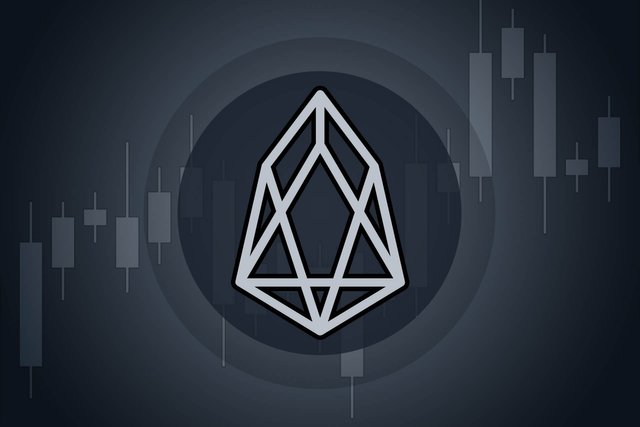
source
The efforts of Daniel Larimer, the creator of bit-shares, a co-founder of the Steem blockchain and current CTO of EOS, led to the creation of the blockchain. He is also accredited for the innovation of Delegated Proof-of-Stake (DPOS). Currently, the CEO of the EOS project is Brendan Blumer.
The EOS platform, a baby in this crypto-verse was launched by Block.one in 2018. Although really young, EOS has proven to be a force to reckon with in the industry. EOS was designed by Block.one to provide a platform for businesses to build decentralized applications. Initially, the company distributed a billion ERC-20 tokens to grant access to use the platform, literally anyone, including you, yes you can use this service easily. Differing from Proof-of-Work blockchains, EOS, through an elaborate voting system popularly called Delegated Proof-of-Stake (DPOS), picks who should handle the progress of a transaction (block producers), they also include multi-threading in this process.
Whats great about the EOS?
Well asides the “little” fact that it is very well rated when it comes to its ability to host decentralized applications, it is absolutely free. Yes, no fees are paid to use this service. The platform is authentic, provides Also, there is security in the sense of the system of voting, availed to block producers to vote on and validate any alterations and edits made to the blockchain.
| Property | Remark |
|---|---|
| Industrial Use Cases | Multi Use |
| Governing Body | EOSIO Core Arbitration Forum (ECAF) |
| Ledger Type | Permissioned |
| Consensus Algorithm | Delegated Proof of Stake (DPOS) |
| Smart Contract Compatibility | Yes |
| Block Confirmation Speed | 1.5 second |
| Token ranking | 22 |
ETHEREUM
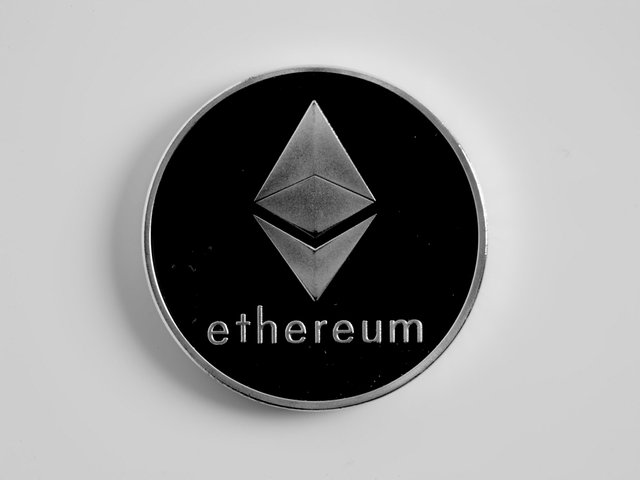
source
Late 2013, a smart Russian-Canadian programmer, Vitalik Buterin decided to contribute to the world, a great innovation, the Ethereum blockchain, an open-source blockchain oriented computing platform. Ethereum is well known for housing smart contracts as the platform is very friendly for programming. The Ethereum Virtual Machine (EVM) affors smart contracts the run-time environment in Ethereum. Every node on the blockchain, has to implement the EVM.
Ethereum is permissionless and uses the proof of work system, which is relatively slower in terms of processing speed. Hopefully, they deem it fit to switch to the proof of stake system.
The ethereum ecosystem has a token named ether. Developers have to pay ethers to access the ecosystem, either by running its dapps and smart contracts, and also executing transactions.
Why choose ethereum?
Ethereum as claimed the title "Father of ICOs" and reasonably so. The ERC-20 made crating tokens easier than riding a bicycle…well…..almost.
Nowadays, all you have to do is model your ERC-20 token against an already existing token that is similar to what you want, see? Easy😎. This was a ground breaking prospect and it pushed the blockchain to immense heights.
Its is also relatively faster than other platforms, including bitcoin, due to faster block production.
It is commendably decentralized, decisions on the blockchain and its general development is through community effort.
| Property | Remark |
|---|---|
| Industrial Use cases | Multi use |
| Governing body | Ethereum Developers |
| Ledger Type | Permissionless |
| Consensus Algorithm | Proof of Work |
| Smart Contract Compatibility | Yes |
| Speed | Eth 1.0: 30 transactions per second (2.0 can handle thousands per second) |
| Token rank | 2 |
Tron
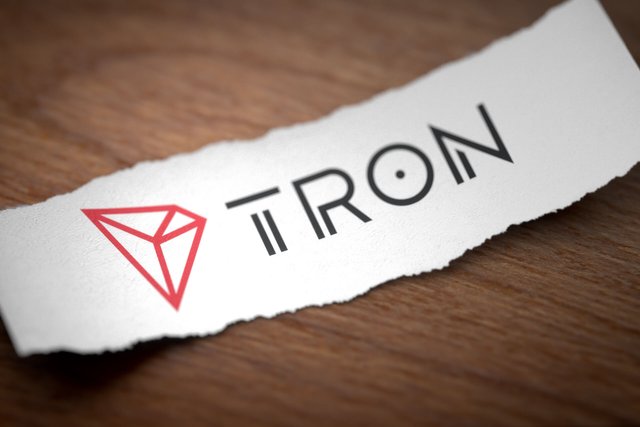
source
2017, a non-profit organization The Tron foundation, headed by Justin Sun, its CEO founded the tron blockchain. They have a dedicated development team that includes renowned tech gurus. Tron is a blockchain embedded decentralized platform that aims to provide a platform for free content sharing, defi services and so on, with distributed storage technology. They also provide easy and very cheap access to the wonders of the blockchain technology. Just like the EOS, tron uses the Delegated Proof-of-Stake (DPOS) consensus system to maintain the ecosystem of the blockchain.
The Tron network has a token, called Tronix (TRX). Tronix can be used by to pay for content, and/or services on the blockchain.
Selling Points of Tron Blockchain?
Tron can actively and efficiently process 2000 transactions per second, which brings it to the table to compete with payment giants like paypal and co. Tron also has zero transaction fees, despite its speed and features.
The Ecosystem is also smart contract-friendly, and Dapp creators have taken a liking unto the ecosystem, especially due to the lack of charges and speed.
So John has this wonderful song, he has to pay to get his music on the platform, and we his fans need to pay to access it. The platform then pays John as they deem fit, which could be very little compared to the revenue his music generates. In comes Tron!
The Peer-to-peer network technology adoption on tron looks to bridge the gap between content creators and content consumers and completely obliterates the middleman and his sometimes excessive charges. This is good for both consumers and producers, cost-wise and in delivery, since the payment for content consumed goes directly to the wallets of content producers.
| Property | Remark |
|---|---|
| Industrial Use cases | Multi use |
| Governing body | Co-governance of Tron Foundation and Tron Community |
| Ledger Type | Permissionless |
| Consensus Algorithm | Delegated Proof of Stake |
| Smart Contract Compatibility | Yes |
| Speed | 2000 transactions per second |
| Token rank | 17 |
Stellar

source
Jeb McCaleb, a co-founder of ripple and Joyce put heads together and birthed the stellar blockchain as an open-source payment protocol. In a lot of ways, like Ripple, but while Ripple’s target market is the established banking institutions, stellar seems to lean more towards the unbanked. Mobile wallets, finance based apps and transaction systems can be built on this blockchain.
Stellar basically works like other blockchain platforms. It is comprised of a network of decentralized servers with a distributed ledger updating every 2 to 5 seconds amongst all nodes. However its consensus protocol is one of a kind.
Special Stellar
Stellar’s consensus protocol does not need miners to verify transactions. Lumen (XLM) as a token for the blockchain is not mineable, 100 billion XLM were created initially. These tokens entrusted to the Stellar Development Foundation. This foundation is charged with distributing 95% of the tokens. Normal users get 50%, Institutions in the ecosystem 25%, bitcoin holders or Ripple get 20%, The remaining 20% are reserved by the foundation to keep the system funded, and continue its development. Stellar uses the Federated Byzantine Agreement (FBA) algorithm, optimized for faster processing of transactions. The protocol employs a portion of the network (quorum slices) to verify transactions.
Nodes on stellar pick "trustworthy nodes" to form a set. transaction has to be verified by all nodes in a set to be considered approved.This system has sped up stellar and it can process up to 1,000 network operations per second.
| Property | Remark |
|---|---|
| Industrial Use cases | Finance |
| Governing body | Stellar Development Foundation |
| Ledger Type | Public and private |
| Consensus Algorithm | Stellar Consensus protocol (SCP) |
| Smart Contract Compatibility | Yes |
| Transaction confirmation time | 3-5 seconds |
| Token rank | 11 |
Conclusion
For curious minds or developers who want to build something on the blockchain, it is important to know the platform that can handle your project how you would like it. People leaning towards entertainment can go for tron, and its free so…..why not?😁👍
General Purposes can be built on ethereum, Stellar is there to handle the technicalities of the financial world if you would prefer, Steem if you want to try something on social media, EOS is general pupose too. There are so many platforms existing, do more research, find what would suit you, DO NOT LIMIT YOURSELF.
Thank you for reading, the blockchain world is a special one that would become a norm soon and I know many of us want to get in on it, for formal or informal reasons. I hope it was easy to learn, and we enjoyed the class. I would love to answer your questions and see your homeworks.
Assignment:
Give a detailed comparison between two blockchain platforms of your choice.
RULES
Post Homeworks in in the community Steemit Crypto Academy.
For Homework Task, add tag #blockchain, #alphafx-s2week1, and #cryptoacademy in the first 3 tags. Also, tag me as @alphafx somewhere in the post.
PLAGIARISM is not right, ensure to avoid it.
Post Requires a minimum of 300 words.
Submit Homework Task Post between 13th April 2021 To 18th April 2021.
Please send your post link under the comments on this post.
Thank You.
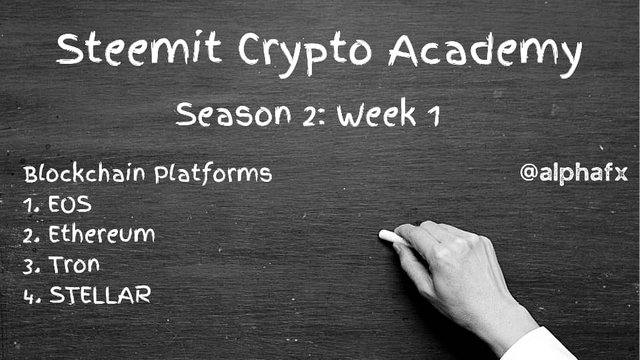

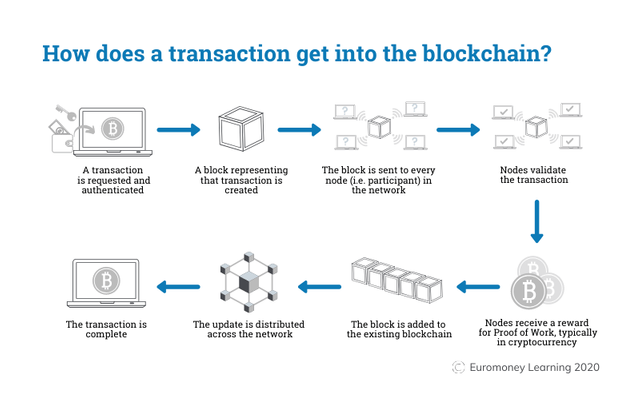
The presentation has been awesome Professor @alphafx.
Thank you so much.
Thank you too.
Hello Professor, this is my Homework
https://steemit.com/hive-108451/@marwone/crypto-academy-season-2-week-1-homework-for-alphafx
Hello, can I summit assignments for each professor or these are limited? Thanks for the lesson!
You are eligible to do all assignments, go ahead.
@alphafx I think there is a mistake It should be 18th April correct it.
Therefore, thanks for your task. I will participate.
thank you, looking forward
For the first time, i want to participate in this assignment. Great presentation.
I appreciate the feedback, Thank you. remember to tag me to the homework 👌
Alright. I will do that. Thank you too
Thanks, professor @alphafx, for your lesson. Deadlain for this work is 18 April?
yes
Goodwork!
Thank You.
MY SUBMISSION:
https://steemit.com/hive-108451/@unyime/homework-1-for-alphafx-or-or-comparison-between-tron-network-and-ethereum-network
seen, thanks for participating.
My homework task: https://steemit.com/hive-108451/@pandev/steemit-crypto-academy-or-season-2-blockchain-and-platforms-by-pandev-my-homework
Thanks to professor @alphafx for the class.
Seen
this is my homework for the first week of Season 2 @alphafx please check it out
https://steemit.com/hive-108451/@nandacoa/crypto-academy-or-season-2-or-homework-task-1-comparison-of-eos-and-tron-for-alphafx-professors
Steemit Crypto Academy Season 2, Week 1|Homework Post for @alphafx| Blockchain and Platforms
done